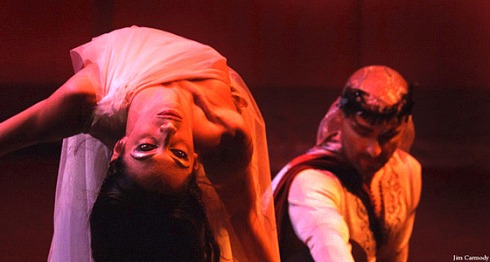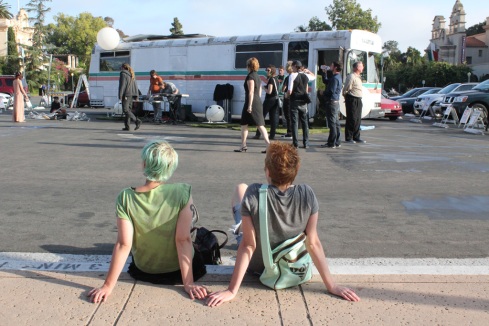What’s in a book? In 2011 UCSD visual arts student Tim Schwartz exhibited two copies of a 1904 text, Modern Methods of Book Composition. One was an elegantly bound copy of the book that had been scanned by archive.org. The other was a Kindle which contained the digital version that had been created from the scan. Under their covers there was a crucial difference. For the traditionally bound copy, Schwartz had written software that covered up all of the book’s text, leaving only pages of black rectangles along with some unexplained diagrams. Everything in other words that hadn’t made it to the Kindle.
Like the blacked-out book, Schwartz’s America’s Time Capsule—now renamed STAT-US—is a project that started out being about what’s there and ended up being about what isn’t.
When he left UCSD in the summer of 2010 Schwartz’s plan was to travel the country in a mobile research lab, a.k.a. an Airstream trailer–shiny and rounded like the 1950s image of a time capsule. To fill it, he was hoping to strike a historian’s version of the Motherlode. His route as a digital data miner stretched from San Diego to Boston with stops at fifty or so libraries, museums and archives in between, and, as Schwartz recalls it, his particular version of gold fever went like this:
”I thought I would be able to find, say, water table data going back a hundred or two hundred years in some small town. Could I collect these long pieces of data? And visualize them in different ways to juxtapose them with larger data trends that I could see?“ His ultimate goal was to compile an image of the United States through local data sources.
The idea was an ambitious expansion of his earlier work. From a college major in physics, through a stint building and curating the digital technology at New York’s Museum of the Moving Image, to the decision to enter art school, Schwartz had been increasingly occupied with giving statistics a tangible, even sensual, form. His first project as a graduate student was a piece called Paris.
It’s an old analog gauge, he explains. “In the middle it says Paris and on one side it says Hilton and on the other it says France. It’s hooked up to the internet and in real time it compares those two Google search values.” The project is still running. Paris, Schwartz says, was his aha moment: “I could make a physical object that captured the essence of the internet and do it a different way than I’d seen before. That’s what moved me on this trajectory.”
The trajectory, though, hit a significant bump almost as soon as his tour began. One of Schwartz’s first stops was at the California State Archive in Sacramento. Among its holdings, he explains, are the computers of every legislator, handed over as they leave office. But like most other state institutions today, the archive has a limited budget. As a result, he says, “they’re sitting in a room. All those hard drives. Nothing has been touched.“
It’s an intriguing image, the room stacked with hard drives, their data sealed away in so much schist, but not the one Schwartz was aiming for. “I had done work before, analyzing usage of The New York Times,” he says. (And embodying that usage in a soaring panel of antique gauges). “But I had to have the full history of The New York Times, all of the data extracted in packages to do that.”
As the tour continued, so did the pattern. Yes, he was finding gold—“there are definitely forgotten archives out there,” he says. Among his finds documented on the STAT-US website are typed note cards describing ski-boots (in Colorado) and a 1930s book of recipes designed for trailer kitchens. But the problem remained, extraction. Little was digitized, he says “and it was everywhere. It would take me weeks to put together one data set.”
Quickly, however, Schwartz realized that he had come across another rich and perhaps more interesting seam. Instead of perusing records he was having conversations. Specifically he began asking how these archives were taking their holdings and making them digital. “What were the challenges? What did they know how to do and what did they not know how to do?” What he soon figured out, he says is that “no one really knew. The digital technology hadn’t been around long enough.”
Unlike Nicholson Baker whose book Double Fold painted archivists as villains heedlessly destroying hard copies of books and newspapers in a spate of digital glee, Schwartz found that the institutions he visited were quite concerned to keep their original items. What digitization offered was wider access to a library’s rarities without the concomitant risk of damage from increased handling. And yet, Schwartz found, gain invariably comes with some kind of loss.
A visit to the Missouri Botanical Garden Research Library brought the problem into sharp relief. In retrospect, he says, it was his favorite stop. “Just getting to see what they physically had, walking around the space or seeing the herbarium with a couple of million plant samples.
The discrepancy between the Library’s antique botanical illustrations and their digitized versions on-line, inspired the piece Botanical Loss, another in Schwartz’s s trio of works from what he term the Digital Dark Age. At first glance, many of the photographs on the gallery walls look black. On closer inspection pale images of flowers emerge. Some have more color than others, but still very subdued. The flowers seem to come from a world without sun.
The originals of the photographs can be found in Robert John Thornton’s illustrated 1799 work, The Temple Of Flora, one of the rarer books in the Missouri Botanical Garden Research Library. A few years ago high quality scans of the Thornton’s lavishly colored plates were made for a Taschen edition of the book. Subsequently, the library made the images of baroquely flared lilies and historic varieties of roses available on line, by uploading jpeg versions to the Biodiversity Heritage Library website.
Loss is often visualized as a black hole, but the connotation is ours, from the analog world. In Schwartz’s version of the Flora, which uses software he wrote to compare the original scans with the online jpegs, black represent a true rendering of the color. It is, in other words, a coded value chosen to denote a pixel that retains the same color in both versions. The lighter the image, the more loss there has been.
Translation, in any language, is imperfect. Translation of color between print and screen especially so. The pixel values, Schwartz say were stated the same in each version of the image, but registered differently in the different mediums. Botanical Loss addresses our assumptions about the digital process as well as its nuts and bolts.
And sometimes, Schwartz found, loss can be opportunity. When Harpers digitized its entire archive, a glitch occurred. (Not surprising for a magazine which has been in business for a century and a half.) In a verbally colorful article on Wild Bill Hickok, published in 1867, a page got skipped in the scanning. For his piece Reimagining Wild Bill, Schwartz asked 15 writers to fill in that blank. Some chose to make a seamless transition, continuing the same American Victorian sentence structure while offering surprising twists to the story of gunslinging prowess. Others imagined streams of consciousness or transmissions from the future. One lovingly created period ads.
The copies, each with a new page, that Schwartz bound and exhibited remind us not only of digital’s pitfalls, but of the whole fragile enterprise of a culture documenting itself. One story out of many gets reported. Accurately or not. A legend may take root, get twisted, be reborn in a dozen new media. A facility may have the disc but not the hardware to open it. The data may become corrupted. The repository go up in smoke. Or the story might never get told at all.
This spring Schwartz had the pleasure of seeing his works infiltrate the libraries that inspired them. He is delivering a set of his botanical prints to Missouri. Meanwhile, one of the six copies of his two volume Kindle composition was purchased by Stanford for its rare book collection. “I love the idea that I’ve been able to push the killer of libraries back into the library,” he says.
For Schwartz technology is a more of a bridge than a tower. “I still think there is inherent value in the physical,” he says. I use digital technology happily, and I am totally ingrained within the digital world in everything I do. But I made a conscious decision a couple of years ago to use digital technology to make physical objects. Because we are all engaged with the digital constantly thru screens. And I think by changing the packaging, it’s easier to reflect about it or understand it.”
“Sitting in my studio in San Diego,” he notes, “I would not have picked up on these ideas. I figured them out along the journey. And through talking to people.”
###
Ariel Swartley
San Pedro, CA
aswartley@att.net




























